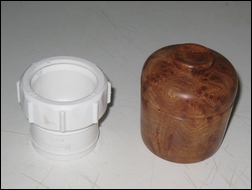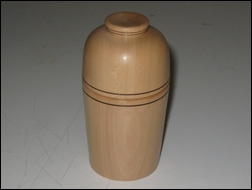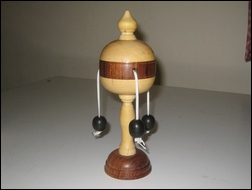Club Night Report
Wednesday 12th August 2015
Club Night Report for 12th August 2015 - observations by Vernon Hughes
The planned 'Club Demonstrators' evening was replaced with a return visit by
Pete Moncrieff-Jury, RPT, (Website:
www.bodrighywood.co.uk) who was our professional demonstrator as recently as January this year. His biography, and a trove of useful/ interesting information, can be found in the report of that meeting, but he reminded us of his reputation for 'turning on a shoestring'. A number of points in the January report link readily to this latest demonstration; e.g. open ended spanners ground to make turning tools, parsimony in the management of timber, etc. On this occasion he took '
Goblets for Use' as his theme and brought along a display of examples of his work in this field to inform our imaginations about the possibilities. The range of sizes from smaller than liqueur glass to larger than a beer glass, all perfectly formed and pleasingly designed, was impressive to put it mildly. He has made goblets as much as 1½ litres in capacity. From the numerous mentions of customer demands and preferences in their purchases it was apparent that drinking vessels are a popular theme.
Pete explained early-on that he uses foodsafe "Rustin's Plasticoat" as the sole finishing product on all of his drinking vessels. He applies six or more coats (by brush) to achieve an absolute liquid-tight, alcohol-resistant, surface. It should be kept in mind that even a micro-dot, pinhole-sized flaw in the surface finish will compromise liquid-tightness. He also advised that the finish should be applied outside the workshop.
Pete made a number of observations on the subject of design, form and variety and history of shapes. One early significant point was that in the most commonly conceived form of goblet (a tulip shape) the curve should be strictly limited to prevent spillage when the bowl is raised to the lips. We should open our minds and imagination to the large array of shapes and designs possible; and we should make vessels out of three or even four component parts (e.g. bowl, stem, foot and decorative extras such as a pewter or brass collar). There are boundless possibilities for decoration and our attention was drawn for example, to the use of cabochon-cut (flat-backed) polished stones that could be applied to create a mediaeval effect. We were also reminded of the colouring to be obtained on Oak by soaking wire wool in lemon juice to create a stain. Mention was made of the symbolism implicit in making two captive rings on the stem of a wedding goblet. Attractive effects can be achieved by using metallic powders mixed with a setting agent for use as fillers in cracks, etc. The range of drinking vessels on display contained examples of all sorts of shapes, decoration and a variety of timbers.
For his demonstration piece Pete had selected three small 'blanks' in Olive, Holly and Damson from which to make three components. There was also a chunk of pewter from which to make a decorative collar. There would not be time to produce a perfectly finished item, but the process would provide every opportunity to follow the principles of design and make, and to convey innumerable snippets of advice and explanation. Upon picking up the Olive blank (say 4" long by 2" square section) for the bowl of the goblet, Pete found a previously undetected split along its full length. Nevertheless, it was mounted between centres for (very careful) roughing down to a cylinder. The split was now seen to be larger than thought at first, but Olive is tough stuff (and we were 'turning on a shoestring') so Pete went on to cut a narrow 10 mm spigot at one end to be fitted in due course into a socket to be made in the top of the spindle, and a spigot at the other end of the cylinder for chuck mounting. The switch to the chuck was then made and tailstock support applied, dimensions were marked out precisely aiming for a 60 mm external bowl height and the basic tulip shape was formed whilst monitoring the split carefully. Then came a truly imaginative move that was a 'first' (for me at least). The tailstock was moved back and industrial grade clingfilm was wrapped generously round the bowl as an anti-shatter precaution during the hollowing out phase. Always listen closely during any work on the lathe advised Pete - as the sound could indicate a crack or other fault long before it was actually visible. He then mentioning that a centre hole can be drilled to the required depth if preferred, although he used a spindle gouge in the time-honoured way. He hollowed out - first with a spindle gouge before switching to a ring tool (which needs care and practice in use), mentioning as the pulling action proceeded that HSS can snap, so keep that in mind as the stress exerted increases. Then came another gem! "Goblet people" don't like a thick rim so aim for thinness just at the very top of the bowl (say 1 to 2 mm). Neat sanding sealer was applied to the goblet bowl avoiding penetration into the split. Then that flaw (aka a design opportunity!) was tackled. CA glue stains wood so the answer was to fill with 'quick' superglue and metal powder (brass in this case). Dental tools make excellent pressing instruments due to their quality and strength and may be obtainable on E-bay. In passing, thrifty Pete reminded us that good quality, distinctively coloured, sawdust should be saved for filling work. He then used a skew to make score marks randomly down the bowl for filling with metal as a means of distracting attention from the split, as well as creating an interesting decorative effect to complement the attractive grain of the Olive wood.
Work then shifted to the Holly stem which would have a hole at the top to receive the bowl spigot and would have its own 10 mm spigot at the other end to fit into a hole in the Damson foot. We were advised that the 'rule of thirds' applies and can be used to dictate the stem and base dimensions in relation to the 60 mm bowl depth (i.e. 120 mm combined length of stem and foot). When incorporating metal collars it pays to use 'Cascamite' (glue) for fixing. Shaping of the stem was proceeding nicely until a collapse occurred at the top end where the fine tolerance between 10 mm hole and stem wall proved inadequate... Pete worked out a means of rescuing the situation but that would have to be a workshop job. He reversed the Holly to permit some further demonstration of design and shaping before switching to the Damson foot. This is a small and simple component to make but there are a few principles and design opportunities to follow. A fairly bland timber should be selected so that it does not detract from the main feature - the goblet bowl. The diameter should always be a little greater than that of the bowl at its widest point to ensure a sense of proportion; and always devise a feature for the dished underside of the foot to add character to the piece. Dishing is of course essential so that the goblet stands on the rim perimeter of the foot to prevent wobble. Also, timber used in goblets must be thoroughly dry to ensure stability throughout in the finished work. To finish the foot Pete used a texturing tool on the top rim, delineating the edge as being an important detail.
Finally he did a little more work on the bowl and made a start on turning the screw-chuck mounted pewter to explain some aspects and fine points of the work.
Conclusion: Despite the mishap with the stem we had enjoyed ourselves to the full and learnt so much. Pete works at a speed and speaks at a pace that leaves everyone breathless except him. Thank you!
<Top of Page>
This month's Show and Tell theme was - A Threaded Item - clearly, not well supported, although the entered items were interesting in their approach.
| This box in Burr Elm incorporated the threaded portion from a 40 mm plastic plumbing fitting |
 |
| A nice box in Holly with inserted threads made in Box wood. |
 |
This month's worthy Show and Tell winner is Bill Savage with a finely executed puzzle box (inspired by John Berkeley) made in Box, Anjan and Blackwood - with a threaded column and lid.
The challenge was to free the beads from the box - without cutting the threads or disassembling the box! |
 |
<Top of Page>





















